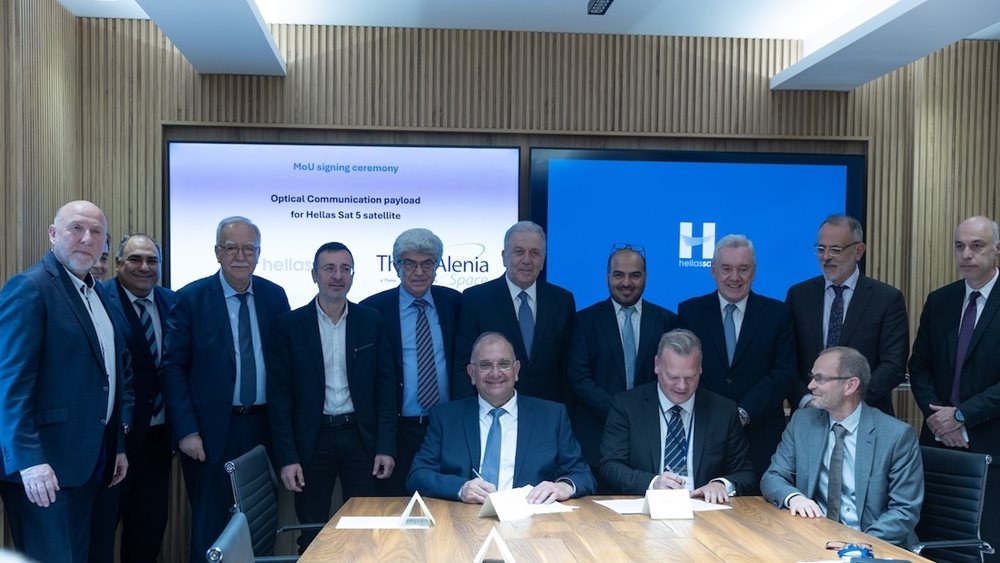The Hellenic Centre for Defence Innovation (HCDI S.A.) announced that on Friday, 28 February 2025, two calls for expressions…

Hellas Sat and Thales Alenia Space, a joint venture of Thales (67%) and Leonardo (33%), signed a Memorandum of Understanding for the joint development of an optical communications payload to be installed on the Hellas Sat 5 satellite under construction.
The collaboration between Hellas Sat and Thales Alenia Space aims to provide state-of-the-art communication services with very high data transmission rates from geostationary orbit.
The aim is for this innovative payload to connect to the optical ground station of the National Observatory of Athens in Greece, the optical ground stations in France, the European Space Agency (ESA) optical ground stations, and Thales Alenia Space’s LEO HydRON telecommunications satellite.
Following the Vertigo H2020 program, Thales Alenia Space is promoting the development of very high data rate transmission technologies of up to 1 terabit/s, capable of traveling long distances from the ground to geostationary orbit and interstellar atmospheric turbulence, with the support of France Relance (CO-OP), CNES (DYSCO) and ESA (HydRON).
According to a statement, the signing ceremony of the Memorandum of Understanding took place at Hellas Sat headquarters in Athens, with the participation of representatives from the Office of the Prime Minister of Greece, the French Embassy in Greece, the European Space Agency (ESA), CNES, Thales Alenia Space France, Italy and Switzerland, the National Observatory of Athens and various Greek Ministries and local authorities.
Also read: Project Nyx Alpha | Telescope in Cyprus for the UK Space Command
Free Space Optical Communications
Free Space Laser Optical Communications are emerging as a space standard, offering significantly greater capacities compared to current satellite communication systems (terabit/sec vs. gigabit/sec). This technology is poised to revolutionize space telecommunications infrastructure, similar to the impact of optical fiber on the ground.
ESA HydRON and CNES Dysco aim at high-performance optical satellite links, research and development, and demonstration, addressing the challenges of providing connectivity to multiple users in different orbits, ground media, and applications. The system showcases the capabilities of optical communications technology in integrated system implementations.
Various use cases include universal internet access, instant transmission of data from observation satellites at any time, private data center connections, and optical fiber redundancy on the ground in case of crises.
The introduction of optical fiber into space is expected to reduce the need for large numbers of satellites in orbit, contributing to the sustainability of the space infrastructure and minimizing sky pollution.
Also read: Airbus | SYRACUSE 4B military communications satellite successfully launched
READ MORE
Greece – Portugal | Defence Cooperation Agreement Approved
The Defence and Foreign Affairs Committee of Parliament has voted in favor of the Defence Ministry’s bill for the ratification of the…
Evelpidon Military School | First Place in the “XVI Commando Half Marathon” in Poland
On Saturday, 15 February 2025, the Evelpidon Military School participated in the XVI Commando Half Marathon with a delegation of three…
Leonardo UK | Introduction of Its New Remotely Controlled Improvised Explosive Devices System Guardian Shield
Capable of causing significant loss of life and damage to infrastructure, the threat posed by remotely triggered Improvised Explosive…
USMC | NMESIS Ready for Deployment
The US Marine Corps is set to deploy the first NMESIS unmanned anti-ship missile battery, marking a significant…
Cybersecurity and Privacy Info Day at the JOIST Innovation Park
The ever-evolving digital landscape compels businesses and professionals to gain a deep understanding of cybersecurity…
Poland | “Survival Guide” for Citizens in Case of Crises
Poland’s government will distribute a “survival guide” to all households in the country this year, aimed at preparing citizens…
DARPA | Launch of the USX Defiant in the Context of the NOMARS Programme
The Defense Advanced Research Projects Agency (DARPA) and the company Serco have successfully completed the construction…
HAVOC 8X8 | Milrem Robotics’ Solution for the Next-Gen RCV
Milrem Robotics has unveiled the HAVOC 8X8 Robotic Combat Vehicle (RCV), a next-generation autonomous platform.
























